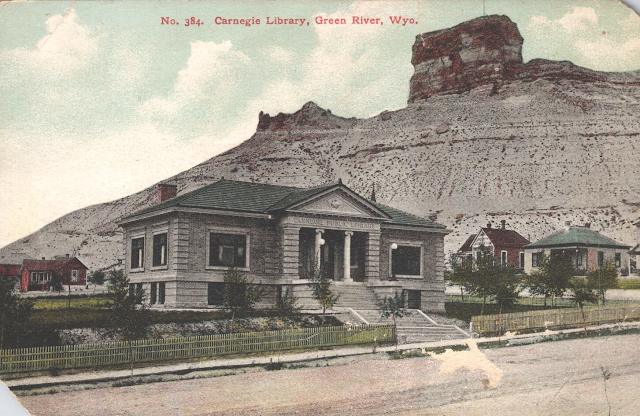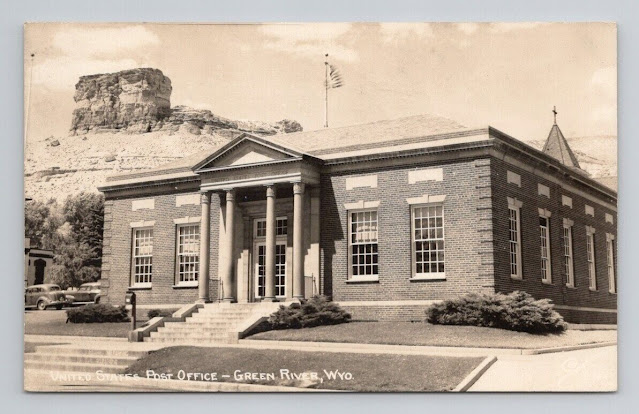Green River, Wyoming
Green River, Wyoming
There have been numerous "Green River" communities sprinkled along the Green River, a stream which has had its share of different names, too. Chances are pretty good that the river was called the "Green" about 200 years ago. Every now and then someone called it the "Spanish River". The local Natives called it the Seedskadee which mean "Prairie Hen River".When the Union Pacific railroad surveyors began pondering how to cross Wyoming, a route through what is now Green River was very much up in the air. Some want to go up through the South Pass route. The more southern route had to traverse the dreaded Red Desert. Eventually, the rail line skirted the southern edge of the Red Desert and ID'd a crossing to its liking below a prominent landmark named The Citadel.
Naturally, a lot of people learned about the route and the crossing and a town sprung up even before the railroad bridge was built. The town usurped the name "Green River" from two other wannabes upriver. The town eventually grew to around 2,000 people before the railroad pulled the plug and moved their division operations west to a pipsqueak called Bryan. Green River puckered up and danged near died. Ironically, Bryan failed because its water source dried up so back to Green River it was. After all, there WAS water in the river and it might get low but it didn't dry up.
Green River was primarily a railroad town for most of its early life. Some local coal mining took place but nothing like its neighbor Rock Springs enjoyed. About 50 years after the railroad spawned Green River, traffic on the new highway US 30 helped pick up local business. A genuine boom took place in the late 40's when trona was "discovered" deep beneath the desert surface. Since then trona has been Green River's economic mainstay.
For the first few decades of its life, Green River was a dusty, desert town with a river running through it. Earlier photographs and postcards of the various towns in southern Wyoming reflect a dearth of trees or grass. The park with the greensward in the postcard below owes its existence to an offhand comment by E. H. Harriman, president of the Union Pacific Railroad from 1904-1907. Edward Henry Harriman (1848-1909) controlled in addition to the Union Pacific, The Southern Pacific, The Saint Joseph and Grand Island, the Illinois Central, Central of Georgia, the Wells Fargo Express Company and the Pacific Mail Steamship Company. Thus, his wishes were to be obeyed and should like expressions from the Diety not to be questioned. On an inspection tour of the Railroad about 1904, Mr. Harriman paused in Rock Springs and commented to the then Division Superintendent W.H. Park as to the railway depot sitting in all of its glory in the middle of the barren right-of-way where not a weed grew, "The station is of attractive design, and some grass and a little shrubbery would freshen things up wonderfully." A local resident responded, "Mr. Harriman, there is not a sprig of grass in Rock Springs; not because we don't want it, but because the percentage of alkali in the soil is an absolute bar to its growth." Harriman replied, "Nothing is impossible."
Source: http://www.wyomingtalesandtrails.com/griver2.html
Eventually, of course, the Union Pacific built a right and proper Depot for Green River.Trona is a Big Deal in Green River. It's almost assuredly the area's top employer and is also probably one of Wyoming's biggest sources of state income taxes and royalties. The City of Green River lists five main trona companies and they are mostly all international conglomerates with either headquarters or connections to India, Belgium, Turkey and the US East Coast. Annual revenues for the four public companies is around $20-billion. The only Green River-based trona company is private and actually connected to a Turkish billionaire. Trona is mostly mined using underground room and pillar techniques. This method has resulted on thousands of miles of tunnels roughly 1,500 feet underground. Trona reserves are said to be at least 100 years even though tens of millions of tons are mined every year. Describing the technicalities of trona as well as trona mining and processing far beyond the scope of this small squib. Here are three links to provide an trona intro:
Here's the City of Green River's simplistic trona page:
https://www.cityofgreenriver.org/246/The-Trona-Industry-in-Sweetwater-County
TATA has an excellent website with a really thorough video regarding their Green River trona ops:
https://www.tatachemicals.com/operations/north-america/our-facilities
And, of course, here's the trona Wiki:
https://en.wikipedia.org/wiki/Trona
We're anxious to see if this Carnegie Library still exists.
The 1930's Post Office is now the museum.
Back in the early 20th Century creation of ornate buildings was a "thing". Such preposterous edifices were erected all over America. Green River was fortunate to host this architectural gem.
Even though much of the original building is long gone, enuf remains to grasp the full flavor of the architect's intent to dazzle and delight. It must have been a memorable and imposing site when it was a highlight of early Green River.














Comments
Post a Comment